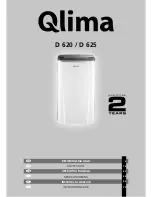
4
1.0 DESCRIPTION
Desiccant is regenerated by driving off (desorbing) the water collected
on its surface. Pressure-swing (also called heatless or heaterless
because no outside heat is added) dryers regenerate by expanding a
portion (approximately 14 - 15% at 100 psig, 7 barg) of the dried air to
atmospheric pressure. This “swing in pressure” causes the expanded air
to become very dry (have a very low vapor pressure). This very dry air
(called purge air) plus the stored heat of adsorption allows the moisture
to desorb from the desiccant. The purge air then carries the desorbed
water out of the dryer.
1.1 Function
1.1.1 Dryer
Dual tower regenerative desiccant dryers are an economical and reliable
way to dry compressed air to dew points below the freezing point of wa-
ter (dew points as low as -150°F (101°C) [1 ppb @ 100 psig, 7.0 barg]
are possible) or reduce the moisture content of compressed air when
used in critical process applications.
These dryers continuously dry compressed air by using two identical
towers, each containing a desiccant bed. While one tower is on-stream
drying the compressed air, the other tower is off-stream being regener-
ated (reactivated, i.e., dried out). The towers are alternated on- and
off-stream so that dry desiccant is always in contact with the wet
compressed air. In this way a continuous supply of dry air downstream
is possible.
Desiccant dryers lower the dew point of compressed air by adsorbing the
water vapor present in the compressed air onto the surface of the desic-
cant. Desiccant is a highly porous solid containing extensive surface
area.
Adsorption occurs until the partial pressure of the water vapor in the
air and that on the surface of the desiccant come into equilibrium. As
adsorption occurs, heat is released (referred to as the heat of adsorption)
and is stored in the bed for use during regeneration.





































